How do you introduce a city like Rome? The capital city of Italy, Rome is one of the most visited tourist destinations in Italy and the world together with other cities such as Florence and Venice.
This romantic and charismatic city is inspired by art and its vibrant yet haunting historical past.
Rome, as you see it today, is a result of over 3000 years of urban development and history and mixes old and modern in a way that only Rome can.
Walking around the city, you will find many relics of its ancient history such as the Roman Forum, Colosseum, and the Pantheon, right in the middle of the city.
If it’s your first visit, Rome is going to wow you even if you’re not a history lover. In any case, it needs to be on your itinerary, no matter if you’re traveling in Italy for two weeks, one week, or one month!
Table of Contents
HOW TO SAVE MONEY AND SKIP THE LINES IN ROME | OMNIA CARD
If you have limited time in Rome and it’s your first visit, consider purchasing the Omnia Card. This card is valid for 3 days and if used well, can really help you save money on transportation and admission to the top tourist attractions, and time thanks to its skip-the-line feature.
What is unique about the Omnia Card is that it is actually two cards in one: Vatican Card and Roma Pass.
This means you have access to 2 of Rome’s top attractions such Castel Sant’Angelo, the Colosseum, and Palatine Hill & Roman Forum, as well as discounts to over 30 other attractions in Rome.
For the Vatican Card perks, you can enjoy entry to a few top sights in Vatican City such as the Vatican Museums and Sistine Chapel, as well as St. Peter’s Basilica.
You also get access to the hop-on-hop-off bus for 3 days, and unlimited rides on the public transport network.
Aside from saving money, another major advantage of having this card is that you can enjoy fast track entrance – meaning, you get to skip the lines… and trust me, the lines in Rome can be looong!
HOW TO GET AROUND ROME

➤ The most convenient and cheapest way to travel within Rome is via public transportation. The Public Transit Bus service runs 24 hours a day and covers the entire city of Rome.
The good thing is that the bus and metro tickets are interchangeable. You can purchase your tickets in advance from vending machines or within the bus or metro stations. Keep your ticket at all times for inspection, or else you could get fined.
The BIT ticket costs 1.50 Euro, which lets you ride a bus or the metro within a specific period of time for 75 minutes. If you’re going to take the bus or metro a few times a day, consider the BIG ticket that costs 6 euros and is valid for unlimited rides on buses and metro.
➤ And speaking of the metro, the metro system in Rome is another efficient way to get around. There are 2 metro lines in Rome: Line A red and Line B blue. Each major tourist attraction is accessible via designated metro stops and the map indicates where to get off, so it’s pretty easy to figure out where to go.
➤ Uber in Rome is limited to Uber Black, Uber Lux, and Uber Van (the most expensive options), so I recommend taking public transportation whenever you can – taxis are very expensive!
➤ You can also rent a car in Rome, but I don’t recommend it unless you are planning to go on a few day trips from Rome. There are areas where circulation is limited, traffic can be a nightmare, and parking is difficult or expensive if you can’t find free parking.
Personally, I would only rent a car for the specific day you want to head out of the city and continue your road trip through Italy – Maybe your next destination will be Tuscany, Umbria, or Marche?
➤ And finally, you can easily walk to many places in Rome if you choose to stay in a central area. I personally really enjoy walking around Rome – just, it won’t be as pleasurable if you visit in July or August when it can get super hot.
3 DAYS IN ROME ITINERARY FOR FIRST TIMERS
There is so much to see and do in Rome, that it can be overwhelming to try and figure out what to prioritize and how to move around. That’s why I wrote this Rome itinerary based on a few visits to the city, so you can make the most out of your 3 days in Rome.
Day 1: Go On a Self-Guided Rome Walking Tour
On your first day in Rome, start your day with a typical Italian breakfast to fuel you for the rest of the day’s activities. A typical breakfast in Rome consists of a quick coffee and some pastries… how does a frothy cappuccino and warm cornetto sound?
The Italian cornetti are distinct from the French croissants because the former is sweeter and is typically filled with Nutella, jam, or custard cream (my favorite!). I always miss cornetti so much when I’m abroad.

For your first stop, start your itinerary at Castel Sant’Angelo. This fortress, also known as Hadrian’s Tomb, is situated along the bank of the Tiber and only a short distance from the Vatican. This building was constructed as a mausoleum for Emperor Hadrian and his family.
When it was completed, it was used as a military building until the plague epidemic happened and Pope Gregory had a vision of Saint Michael the Archangel at the top of the castle. Due to his apparition, the building was crowned with a statue of an angel.
The castle is currently split into five floors and there are numerous rooms, some of which served as Papal residence when the Pope needed to be somewhere safe, and it’s currently where the Pope spends his summers.
You can visit the castle with its luxuriously decorated Papal apartments and prison cells, and enjoy some fantastic views over Rome from the fortress terrace.
Opening hours: Daily from 9 AM to 7.30 PM.
Entrance Fee: 20 Euros for adults. Free entrance for children under 18 years old.

Then, head to the Pantheon, another Roman iconic landmark that is a must-visit when you are touring the capital city. The Roman Pantheon is known as the biggest brick dome in architecture history, as well as the forerunner when it comes to places of worship. It’s gigantic!
When you enter and you look up at the dome, the Pantheon feels big and opulent, and really different from all other buildings in the city.
The Pantheon was built from 25 to 27 BC, and then rebuilt in 125 AD after a fire, and it’s the most complete ancient building in Rome. The Pantheon can be accessed for free, and there are never queues, so really there are no excuses for missing it.
Remember that it’s still a church, so please remain silent during your visit.
Opening Hours: Daily from 9 AM to 7 PM.

Your next stop is Piazza Navona, one of the most beautiful piazzas in Rome. This square of Baroque style is known for its three impressive fountains, but the most impressive among them is the Fontana dei Quattro Fiumi which comes with a large obelisk and was designed by Bernini.
Within the square, you’ll find a number of restaurants, musicians, and painters, so expect a lively atmosphere. This is also the best area to stay in Rome in my opinion – if you have limited time in Rome, from here you can walk to most attractions in the city.
On our last visit (well, first for Fran), we stayed at Relais Rione Ponte and it was the perfect base for our quick visit. I’ll tell you more about our experience at the hotel in the Where To Stay section.
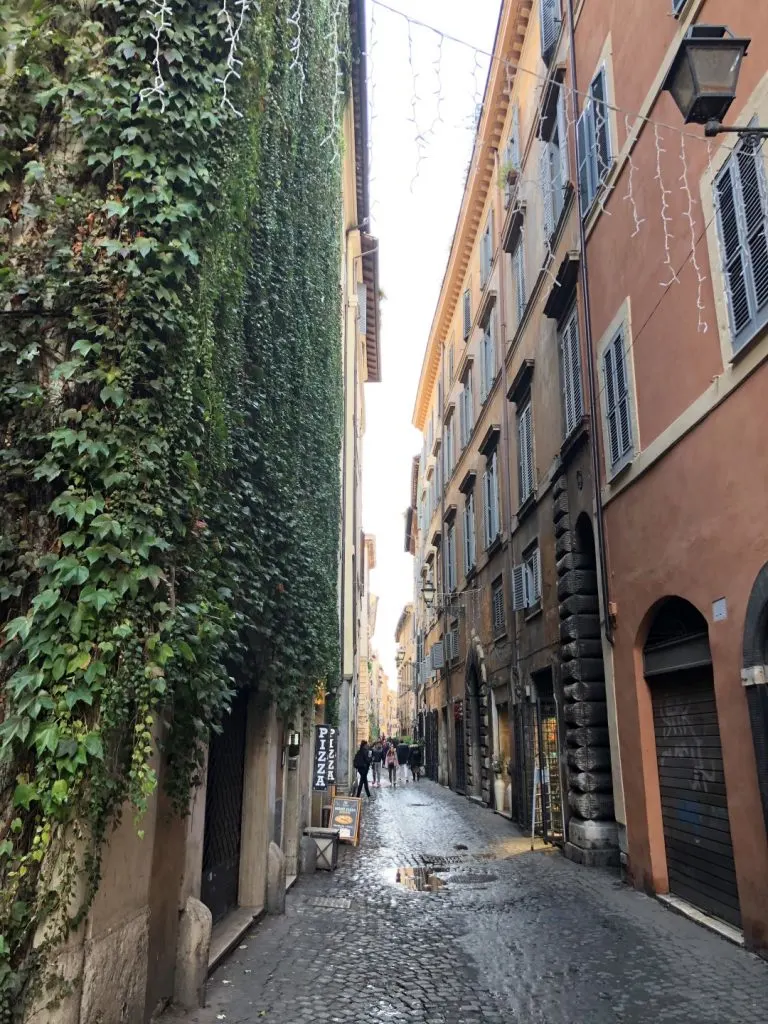
On the way to your next destination, pass through Via dei Coronari. This is a pretty street with perfectly imperfect twisted lanes. This area of Rome is a photographer’s dream!
Most of the buildings that can be found along this street are from the 15th-16th century, and this whole area is known for preserving the Italian Renaissance vibe.

Your last stop in the morning (I know it’s quite a lot!), is Campo de’ Fiori. This is another lively square in Rome and its name literally translates to “fields of flowers” because the site of the square was once a flower field until it was paved in 1456.
There is a flower, fruit, and vegetable market held here during the day and although it’s honestly pretty touristy, it’ll give you plenty of options for souvenirs and things to bring back to your country such as oil or spices.
➤ Fan of mystery and Dan Brown novels? Check out the themed Half-Day Angels and Demons Official Tour. You’ll visit the locations featured in the Angels and Demons film, based on Dan Brown’s best-selling novel. You will stroll famous piazzas in Rome, as well as some of the secret passages and hidden historical sights. ➥ BOOK IT HERE

After a quick lunch, resume your exploration of Rome’s top sights with the Altare della Patria (Altar of the Fatherland) as your first stop. Located in Rome’s city center, the Victor Emmanuel II National Monument (this is the official name) is quite impressive – actually, it’s massive!
This building was erected on Capitoline Hill to commemorate the unification of Italy under Victor Emmanuel II, who was the first Italian king.
The Victor Emmanuel Monument holds the tomb of the unknown soldier, and a museum dedicated to the unification of Italy. If you’re looking for great views over Rome, you can go up to the panoramic terrace in an elevator (highly recommended).
Opening Hours: Daily from 9.30 AM to 7.30 PM.
Elevator Ticket: 10 Euros.
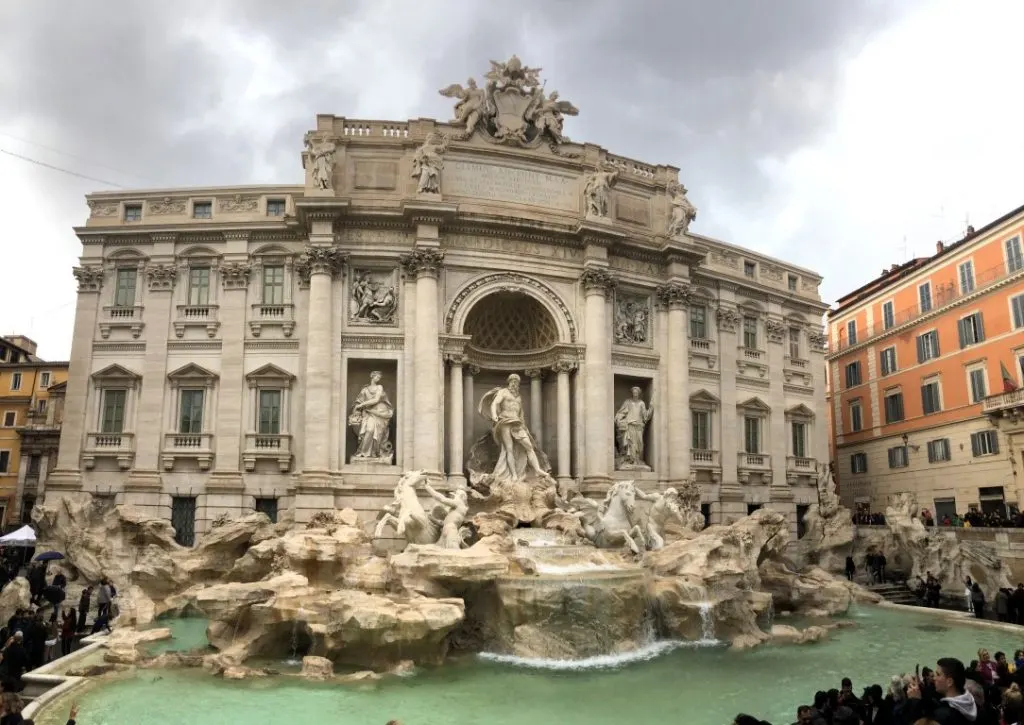
And is there a more heavily photographed tourist attraction in Rome than the Trevi Fountain? Known as the largest Baroque fountain in Rome, this is also arguably the most famous fountain in the world.
It gets millions of visitors every year, and the legend says that tossing a coin will ensure your return to the Eternal City. If you toss two coins, you’ll also fall in love, and three coins means you’ll get married!
Fun fact: due to the number of tourists who throw coins into the fountain to make a wish, it is believed that a million Euros worth of coins is collected from the fountain every year.
Since 2007, that money is used to support charity causes in Rome, so keep throwing away!
It’s almost impossible to visit the Trevi Fountain without the crowds – your only chance is to come here super early in the morning (at sunrise), otherwise expect around a million people around the fountain, especially in the afternoon.
The last time I visited, it was literally impossible to get to the fountain as there was a human wall a few meters wide in front of me. For a more relaxing experience, consider waking up early and making it the first stop on your Rome itinerary.

You can continue your afternoon stroll in Rome by heading to Via Condotti. This busy yet fashionable street in Rome is famous for being the most expensive street in Rome.
Here you’ll find all the biggest designer brands, but even if these go over your budget, wandering around here is always nice (it’s even better at Christmas with all the lights!).

Follow the street all the way to Piazza di Spagna. At the center of the square, you’ll find the Fontana della Barcaccia by Bernini, but the square is mostly famous for the imposing Spanish Steps.
This is a set of steps in Rome with Piazza di Spagna at its base and Trinita dei Monti Church at the top. You can find these steps at the eastern end of the old city center. These steps were built in Rome in 1723.
Remember all those photos of people sitting on the stairs? Don’t do it! As of 2019, it’s now illegal to sit on the Spanish Steps as they were slowly getting destroyed – expect a pretty hefty fine if you break the rules!
EVENING: Pasta Making Class or Food Tour
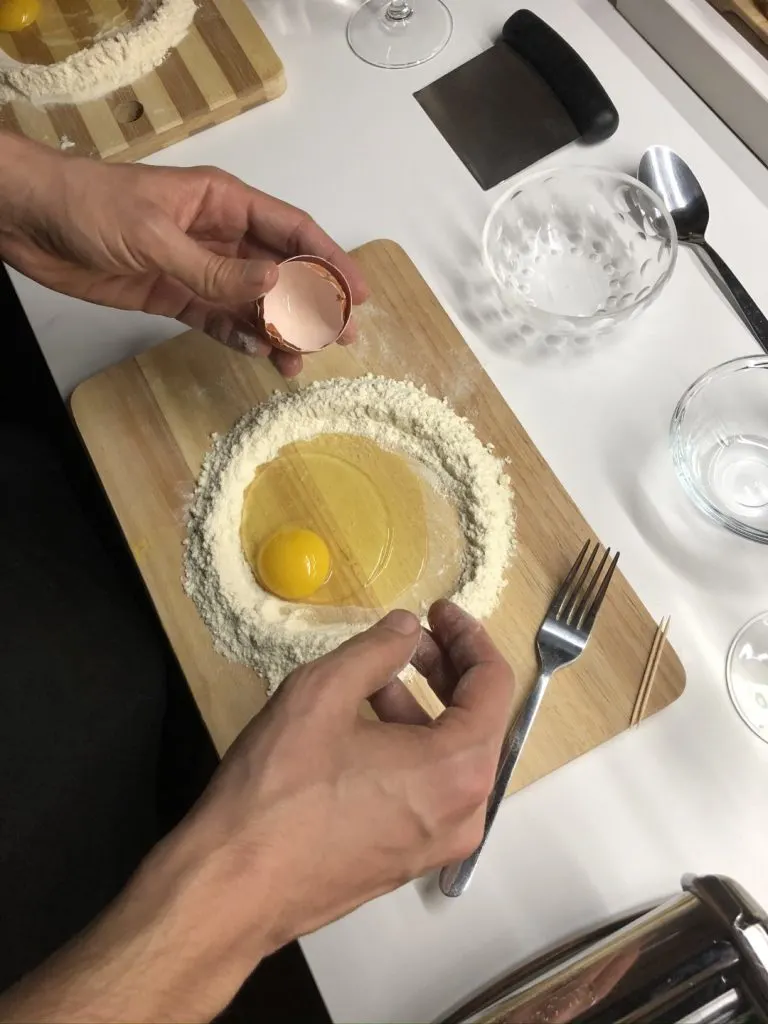
When in Rome, it would be a shame to waste the evening, right? I have two ideas for a super fun night depending on how lazy you feel (do you want to cook or you prefer to just eat? No judgment!).
I have written two articles about the best cooking classes and the best food tours in Rome, but here below are my top picks.
➤ My first recommendation is the Rome Pasta-Making Class: Cook, Dine & Drink Wine with a Local Chef, where you’ll learn how to make authentic Italian pasta from scratch, as well as two types of pasta sauces… all mixed with good amounts of wine! I’ve participated in the same exact pasta-making class in Florence and it was the highlight of my visit. So much fun! ➥ BOOK IT HERE
➤ If you would rather not cook, you can join this Trastevere & Historic Center VIP Food Tour with Rooftop Spritz. You’ll sample delicious bites of Italian cuisine as you explore local haunts, enjoy a craft beer tasting, and make your own Spritz on a rooftop. ➥ BOOK IT HERE
DAY 2: The Vatican + Colosseum
There’s so much to do and see in Rome that it might almost seem impossible to see all the highlights in just 3 days. That’s why if it’s your first visit, I suggest one or two guided tours so you can learn about Rome’s history.
While you can easily follow the itinerary of the first day on your own, when it comes to the Colosseum and the Vatican, having a guide with you is highly suggested.
Since these are the main attractions in Rome, I’ve written two posts about the best Colosseum tours in Rome and the best Vatican tours in Rome. Down here I’ll tell you about my experience, but make sure to check them out for more options.
When we booked a Vatican City and Colosseum tour, it was mainly because it was Fran’s first visit to Rome. I had already visited Rome a couple of times, but never with a guide… and well, I’m sold.
I learned a lot on this tour thanks to our guide; it’s so different to look at buildings and art with someone who will tell you all about their history and anecdotes!
➤ The Rome in a Day Tour with Vatican, Colosseum & Historic Center is perfect for your second day in Rome. The tour starts with a tour around Rome’s major sights, including Piazza Navona, the Colosseum, the Pantheon, the Trevi Fountain, and the Roman Forum, with a convenient break for lunch in between.
You’ll then visit the Vatican Museums and the Sistine Chapel with skip-the-line tickets, and an expert guide to tell you all about them. ➥ BOOK IT HERE
I’m not going to lie, it’s a pretty full day, but when you have limited time, it enables you to see all the top sights within a single day. If it seems too much, though, you can just book one of the tours: the Vatican or the Colosseum.
➤ Rome: The Original Entire Vatican Tour & St. Peter’s Dome Climb
➤ Colosseum Arena Floor & Ancient Rome | Semi Private Max 6 People
If you would rather explore Rome on your own, of course you can also do that! I still strongly recommend visiting with a guide at least some of the attractions as you wouldn’t really learn much by just visiting them on your own, but this is just a sample itinerary that you can move around the way you like it.
Start your second day in Rome by exploring the Vatican Museums and the Sistine Chapel. I’ve written an extensive guide to the best Vatican and Sisitine Chapel tickets and tours. I recommend to check it out before your trip!
If you are taking the subway, there are two stops close to here: Cipro and Ottaviano, otherwise, there are multiple buses that alight directly at the Vatican. Another option is to get here via the hop-on hop-off bus, which conveniently takes you directly to the Vatican Museums.
If you haven’t bought a skip-the-line ticket in advance (highly recommended!), get here as early as you can – during high season the lines are incredibly long, and you might end up waiting under the sun for hours.
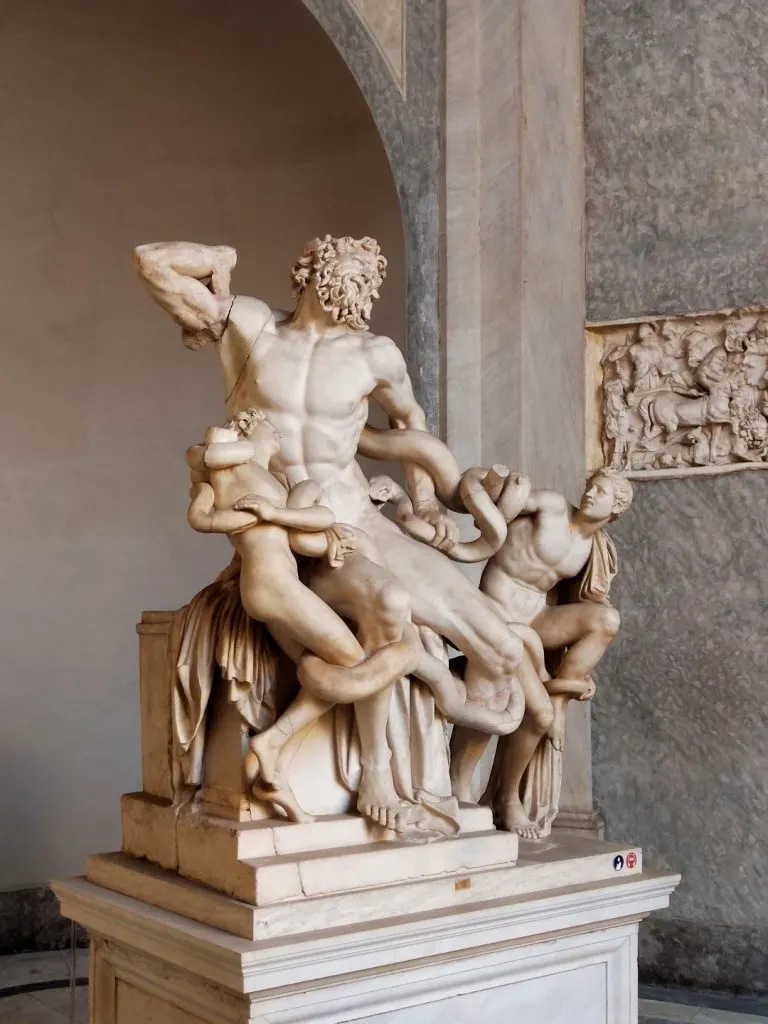

The Vatican Museums are considered one of the most important museums in the world, and over 6 million people visit it each year – no kidding! You also have to consider that the Vatican Museums are gigantic (42,000 square meters).
You could spend days looking at the 70,000 exhibits, of which the most important are in the rooms of Raphael and the art gallery.
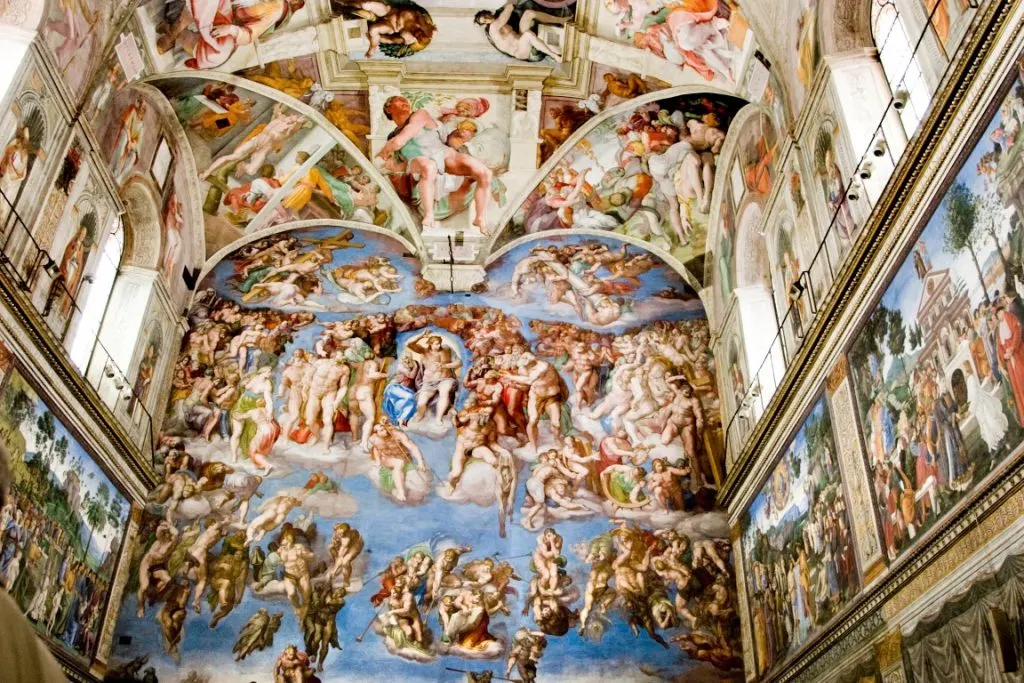
The absolute highlight of the Vatican Museums, though, is the Sistine Chapel, known as one of the best treasures of the Vatican…. and probably the world?
The jaw-dropping frescoes inside the chapel are a masterpiece of Michelangelo, who spent four years painting the vaults of the chapel (1508-1512).
The most prominent of these frescoes are the nine stories from Genesis that are featured in the central area of the chapel’s vault.
Opening Hours: Monday to Thursday from 8 AM to 7 PM, Friday and Saturday from 8 AM to 8 PM. Last entry is one hour before closing time. Last Sunday of the month form 9 AM to 2 PM.
Entrance Fee: 20 Euros. Last Sunday of every month the entrance is free.

From the Sistine Chapel, head to another iconic landmark in Rome – St. Peter’s Basilica. This Renaissance-style church was built in Vatican City to serve as the papal enclave.
This church is considered the holiest for the Roman Catholic religion and is a popular pilgrimage site among devotees, although you don’t have to be religious to appreciate its architecture and the art it contains.
The basilica can accommodate up to 20,000 people at one time and features an impressive collection of art. Among these art masterpieces on display are The Pieta, a famous sculpture by Michelangelo, and The Throne of St. Peter.
Opening Hours: Daily from 7 AM to 7 PM (summer times). It closes at 6.30 PM in winter.
Entrance Fee: Free, although climbing up to the top of the dome costs 8 Euros.
For lunchtime, avoid dining at super touristy restaurants near St. Peter’s Basilica – there are tons of them and many are overpriced. One good option is Pizzarium Di Gabriele Bonci, which sells pizza by the slice. Their pizzas come with a light dough and they have a selection of tasty toppings.
An important tip to keep in mind: when looking for a place to eat, don’t settle for the first place you find.
I usually try and find a couple of options in advance If choosing a place on the go, check the menu to make sure the food isn’t overpriced, and also check if there are locals eating or it mostly seems a touristy place, which often means not-so-great food. It’s better to grab a sandwich than to go to a touristy sit-down restaurant.

In the afternoon, your first stop is the Colosseum. Located in Piazza del Colosseo, this is one of the most famous landmarks of Rome. Also known as the Flavian Amphitheater, this oval amphitheater is built with travertine limestone, brick-faced concrete, and tuff.
At the time it was constructed in 70 AD, it was the largest ever built of its kind that can hold 50,000 spectators.
You probably know from the movie Gladiator that the Colosseum was the theater of epic battles between gladiators and animals, and executions happened here regularly. And even naval battles if you can believe it (they flooded the stadium on purpose!).
Really, you can’t go to Rome and not visit the Colosseum. It would be like going to Paris and not seeing the Eiffel Tower, or going to Venice and not seeing Piazza San Marco!
Opening Hours: Daily from 8.30 AM to 7.15 PM in the summer. In winter it closes at 4.30 PM.
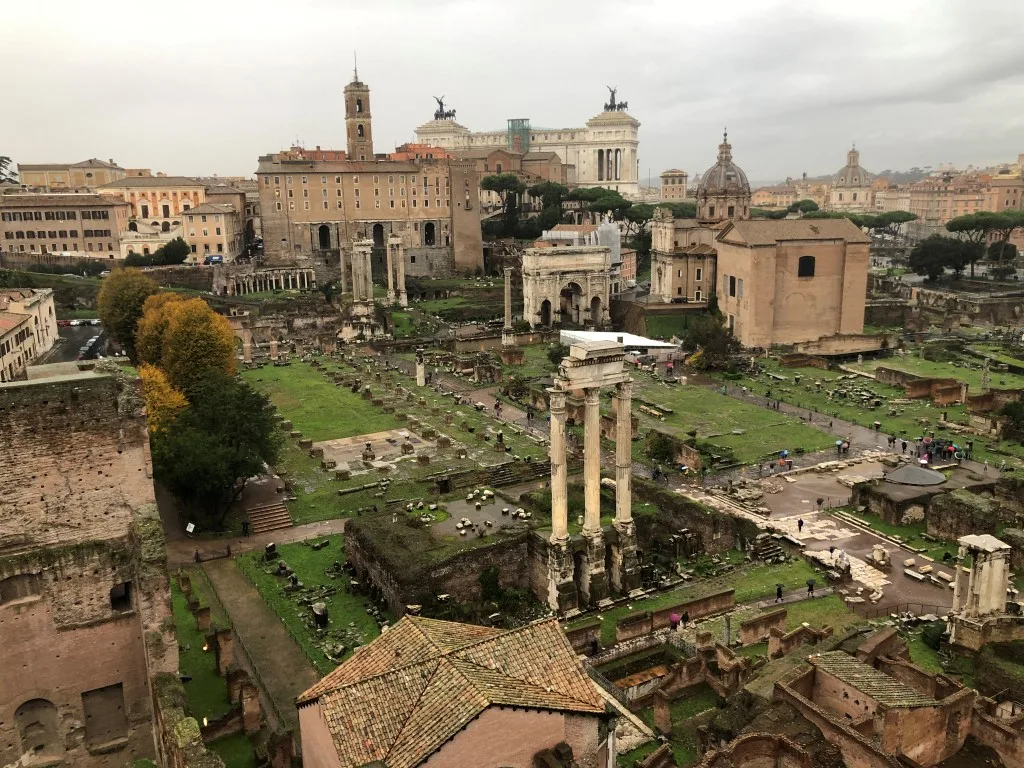
From one Roman icon to the next, your next destination is the Roman Forum. This rectangular forum is flanked by the ruins of several ancient government buildings located within the heart of Rome.
The Roman Forum served as a venue for public meetings, gladiatorial combats before the Colosseum was built, and law courts.
The city of Rome has to regularly restore the ruins, and they’re really impressive. It’s just so strange to see these incredible ruins in the middle of the city! Truly an open-air museum.
Opening Hours: Daily from 8.30 AM to 7.15 PM in the summer. In winter it closes at 4.30 PM.
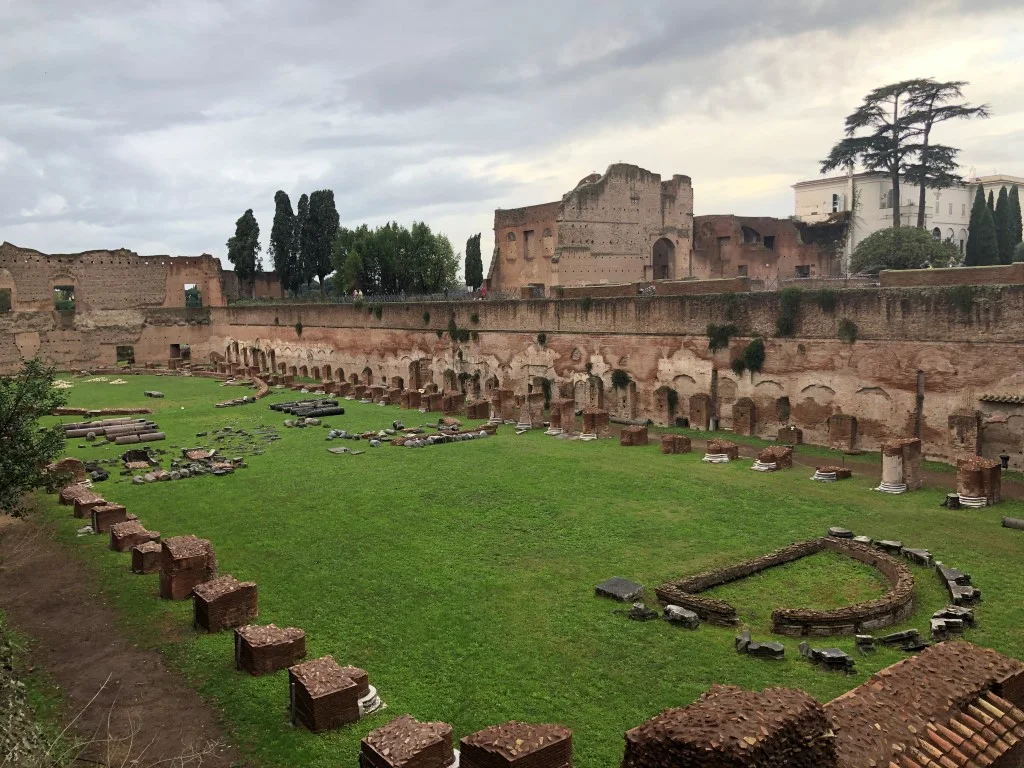
For your last destination of the day, head to Palatine Hill. This is the most central of the Seven Hills of Rome, and is known as the first nucleus of the Roman Empire. According to legend, in fact, this hill is the birthplace of the Italian capital when Romulus founded the city of Rome from this hill.
The most special ruins that you shouldn’t miss while visiting Palatine Hill are the Domus Flavia, House of Livia, Farnese Gardens, Palatine Museum, and the House of Augustus.
I suggest just scrolling around the hill. Even on a hot day, you’ll be protected by the shadow of the trees. From Palatine Hill, you can also get some great views of the Roman Forum from above.
Opening Hours: Daily from 8.30 AM to 7.15 PM in the summer. In winter it closes at 4.30 PM.
And you’re done for the day! For dinner, why not go traditional and have pizza? There is no shortage of options when it comes to good pizza places in Rome, so make sure to add the following to your list of options:
• La Pratolina
• Piccolo Buco
• La Gatta Mangiona
• Pinsere
DAY 3: Trastevere + Villa Borghese
For your third day in Rome, there is no better way to spend your morning than to walk around the lovely neighborhood of Trastevere.

This neighborhood is located across the Tiber River and was once a working-class district. Today, it’s become a lot more touristy, especially popular among the people who want to experience a more authentic side of Rome.
Wander around its streets and narrow lanes without a destination, and you’ll see that life here goes a lot more slowly.
If you visit Trastevere on a Sunday, don’t forget to check out Mercato di Porta Portese. This is a massive flea market in the neighborhood that is a go-to destination for bargain hunters. The market features thousands of stalls that sell all kinds of items you could think of – from rare books, bikes, shawls, and so much more!
This is a CRAZY busy market and for me, the best part is the vendors who shout and sing to attract customers – it’s like a free show! Just be sure to keep a close eye on your valuables, as pick-pocketing here is pretty common.

By lunchtime, I bet you’ll be hungry and tired from all the walking around… I know, I’ve been there. My recommendation is to stop at Tonnarello for lunch. This no-frills tavern is located in the middle of Trastevere and serves traditional Roman cuisine.
The recipes have been handed down from generation to generation, and the food is delicious although heavy because that’s how Roman (and Italian) cuisine is. Don’t expect to have a salad here – opt for one of their homemade pasta dishes and finish your meal with tiramisu.

In the afternoon, head straight to Piazza del Popolo. This is a large urban square whose name literally translates to “People’s Square”. Within the square, you will find the Egyptian obelisk that was dedicated to Rameses II known as Flaminio Obelisk.
There are also two churches located close to the square – Santa Maria dei Miracoli and Santa Maria in Montesanto. While these two churches look exactly the same on the outside, head inside and you will see the differences for yourself.

Next, head up to Pincio Hill, in my opinion, one of the most romantic and picturesque places in Rome. It’s not one of the Seven Hills like the Palatine Hill, but you can enjoy stunning views of Rome from up here.
You can see the Piazza del Popolo, the Vatican, and the historic center of Rome… and if chance you can come back for sunset, everything gets colored with a million warm hues, and it’s super romantic!

From Pincio Hill, make your way to Villa Borghese Park. It’s considered the green lung of Rome and spans a total land area of 80 hectares filled with sculptures, buildings, lakes, and fountains.
Can you believe that before 1606, when it was converted into Rome’s most extensive garden ever built, the park was a vineyard in the countryside?
You could spend hours walking around this huge park, and a great way to spend a day would be bringing your own food and having a picnic… but unfortunately, we don’t have so much time, so head to your next destination walking through the gardens.
Opening Hours: Daily from dawn to dusk.
Entrance Fee: Free.

When you’re done exploring the gardens, visit Galleria Borghese (Borghese Gallery), which hosts an impressive collection of paintings by Caravaggio, Tiziano (Titian), and Bernini.
It’s important to book your ticket to the gallery in advance because only 360 people are admitted at a time. Each visit is limited to two hours to give way to the next batch of tourists. You can reserve your slot any hour from 9 AM to 5.45 PM.
On the first Sunday of the month from October to March, you can visit the museum for free, but you still have to book your visit on the official site.
Opening Hours: Tuesday to Sunday from 9 AM to 7 PM.
Entrance Fee: 13 Euros. Those aged 18-25 pay 2 Euros.
WHERE TO STAY IN ROME
Book your accommodation by using the map below ⬇
MY RECOMMENDATION: RELAIS RIONE PONTE
When it comes to choosing a hotel in Rome, location is everything. Trust me, after a long day walking around the city, you want to come back somewhere cozy and central so that going back out again for dinner or a night out won’t feel like a chore.
We found that place at Relais Rione Ponte, one of the best boutique hotels in Rome, and choosing the right hotel made our visit a lot easier.
Relais Rione Ponte offers nice, cozy rooms to rest your tired bodies while keeping you close to iconic attractions such as Piazza Navona and the Pantheon.
This boutique hotel is located inside a 17th-century building and is literally steps away from Piazza Navona, which in my opinion is the most beautiful square in all of Rome. From here you can walk pretty much everywhere: Trevi Fountain, Castel Sant’Angelo, the Vatican, and more.

We spent the first two nights of our stay in a Deluxe room, and our last night in the Junior Suite.


Our Deluxe room came with a little cozy corner with a table and a coffee and tea machine, and the Junior Suite had a separate seating area. Both featured soundproof windows and nice views.

Wifi worked very well, which allowed us to work a little during our stay. My favorite part was probably the very spacious bathroom which came with double sinks, luxury and eco-friendly toiletries by NUXE, and a super large shower with a Turkish bath.

Relais Rione Ponte is also a hotel with a unique flair as there is a focus on art. The rooms and lounges of this hotel feature original works by contemporary artists. Spazio Arte is basically a gallery of modern art within the hotel, where the paintings change a few times a year.
When we were there, the hotel was featuring a collection called “Nothing but Flowers” and the paintings were made by the artists of the previous exhibitions.
When we first arrived at the hotel, the check-in was fast and smooth, and we were whisked to our room in a heartbeat. Throughout our stay, we always felt very welcomed, and they gave us a list of recommended restaurants to check out.

There’s a lounge in the hotel where guests are welcome to relax with a book and a coffee – you’ll find a Nespresso machine with complimentary pods, that can be used whenever.
Every day, if you’re around at aperitivo time, you’ll also be offered a glass of sparkling wine and something to snack on.

Breakfast was simple but good quality. It consisted of a buffet with sandwiches, yogurt, jam and muffins, and fresh croissants that came straight from the bakery still hot mmmmmm so good. We ordered cappuccino to go with it.
You might be thinking that a hotel in such a good location must cost a fortune, but you’d be pleasantly surprised. Relais Rione Ponte offers great quality for value, with rooms starting at a little over $100 per night for a Classic room in low season. It’s a steal considering that Rome is not a cheap destination and how much hotels in this area go for!
Overall, we had a terrific experience at Relais Rione Ponte. We definitely recommend staying here!
CHECK OUT AVAILABILITY AND RATES
BEST TIME TO VISIT ROME
The best time to visit Rome is from September to November or April to May. The weather conditions in this time are good – bright and sunny, not too hot or too cold.
You can expect sunny days and cool and crisp evenings that will require you to wear a light jacket. Expect crowds in Rome at any time of the year, but it’s way less crowded at this time than during the summer.
Keep in mind that the hottest and most humid time of the year are the months of July to August. These are also the most crowded months in the year, so I highly suggest visiting at another time of the year if you can.
On the other side, the months of December to March bring chilly weather. This last time we visited at the end of November and it was already pretty cold and rainy, but there are definitely fewer people around and accommodation is cheaper. If you don’t mind the cold, it’s a good option.
I hope this guide was useful to plan your Rome itinerary – if you have any questions, please let me know in the comments!
I was a guest of Relais Rione Ponte but the opinions contained in this article are 100% my own. I wouldn’t lie to you and would definitely go back to this hotel on my next visit.
This post contains affiliate links, which means if you book something through one of my links I might get a commission, at absolutely no extra cost to you
